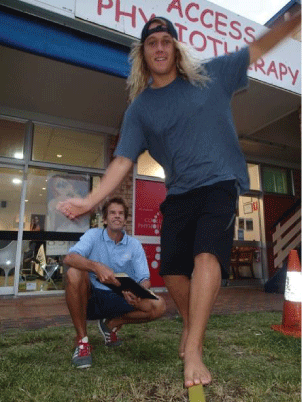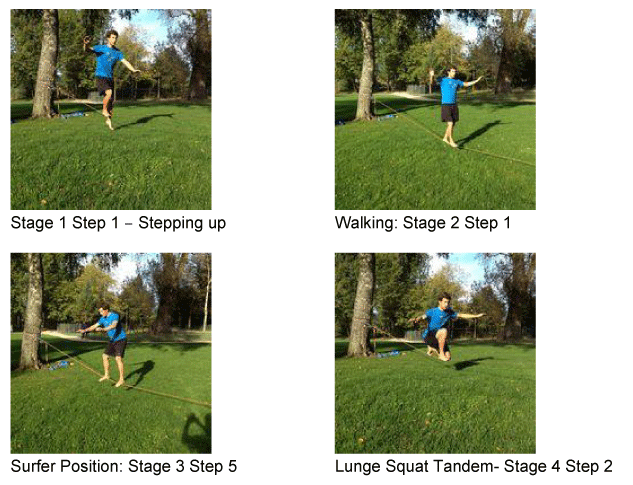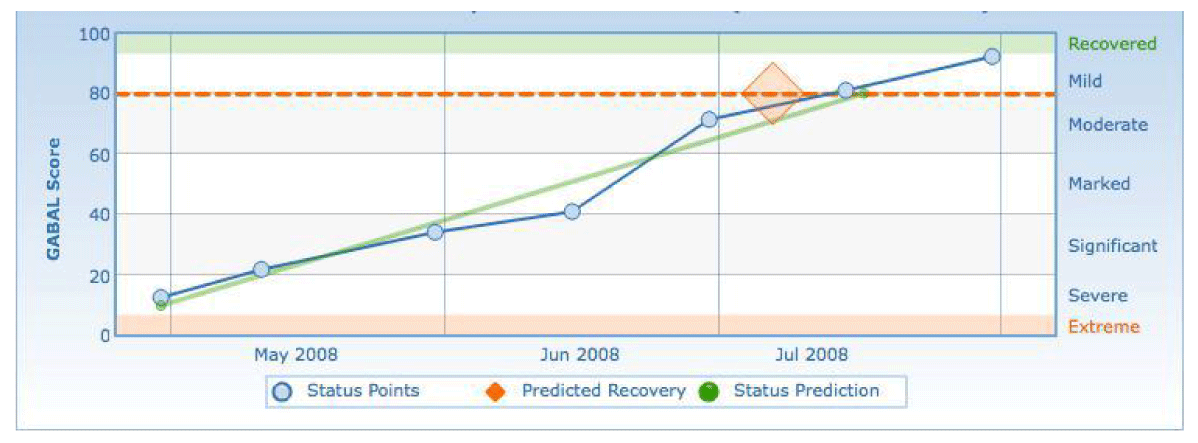Mini Review Open Access
Slacklining: A Novel Exercise to Enhance Quadriceps Recruitment, Core Strength and Balance Control
| Gabel CP* | |
| University of the Sunshine Coast, Queensland, Australia | |
| Corresponding Author : | Gabel CP University of the Sunshine Coast Queensland, Australia Tel: 61754461022 E-mail: cp.gabel@bigpond.com |
| Received: June 28, 2014, Accepted: October 13, 2014, Published: October 21, 2014 | |
| Citation: Gabel CP (2014) Slacklining: A Novel Exercise to Enhance Quadriceps Recruitment, Core Strength and Balance Control. J Nov Physiother 4:229. doi: 10.4172/2165-7025.1000229 | |
| Copyright: © 2014, Gabel CP. This is an open-access article distributed under the terms of the Creative Commons Attribution License, which permits unrestricted use, distribution, and reproduction in any medium, provided the original author and source are credited. | |
Visit for more related articles at Journal of Novel Physiotherapies
Abstract
Quadriceps activation is critical for lower limb movement and subsequent rehabilitation. However, selective quadriceps activation is compromised by impaired neuro-motor activation, loss of function and pain. A recently introduced method of prehab- and rehabilitation exercise to recruit quadriceps is ‘Slacklining’. This is a complex neuromechanical task that involves balance retention on a tightened band where whole-body dynamics drive the response to external environmental changes. A challenge to the implementation of slacklining is the understanding of its mechanisms of action, a standardized protocol for ‘slackline’ training and the incorporation of this technique into exercise programs along with knowledge of the literature supporting its use. This article summarizes the background to the use of slacklining and how it can supplement recovery goals through a stimulating positive therapeutic experience. It details slacklining’s ability to automatically recruit the quadriceps, the research support for this use, the proposed sequential and progressive protocols for both clinical and research application, areas of caution and the directions for future use and research. Slacklining provides a unique composite-chain activity with higher levels of quadriceps activation and recruitment than traditional exercises that are achieved with significantly less exertion. This enables a positive and progressive form of rehabilitation that achieves outcomes at a potentially faster rate. This is of particular relevance for the outpatient setting and circumstances where the quadriceps is inhibited and activation is required.
When we think of recruiting the quadriceps it can be through isolation - muscles alone, or integration - combining stability and mobility [21]. Traditional rehabilitation is a graded progression from isolation - getting it to work, to eventually making it part of the body‘s integrated movement process. In traditional rehabilitation a muscle group or component is isolated, as in the medial quads exercises. This enables the patient to see, feel and understand the actions and activity of the required muscle and why it needs to work. Electromyographic (EMG) biofeedback is one way to facilitate this process, helping the brain realize and accept what is happening, that it is a positive action, and that it should be continued and established as a normal function. Once inhibited or weak muscles have been recruited and voluntary activity and intensity gained, therapists in rehabilitation usually progress rehabilitation and exercise therapy to more complicated and combined movements before the more contiguous parts of daily function and activity are focused upon. The problem with this process is that, though foundations of movement are considered and accepted, it can be slow, stages must be learnt, frustration creeps in, and once learnt, they must often be effectively unlearnt to get the required integrated activity and return to ‘normal’ function.
Weight-bearing or non-weight-bearing knee-extension exercises are well recognized as not acutely changing quadriceps torque or activation levels [6]. Selective muscle activation is difficult due to pain inhibition, functional loss and impaired neuro-motor activation [17]. The process of any muscle activity including quadriceps) occurs through one of three methods: open, closed or composite-kinetic chain activity – this occurs when there is a weak link in the kinematic chain that creates abnormal motor synergy patterns [24]. It’s this latter, less-recognized aspect that is perhaps an untapped resource. It occurs when there is a weak link in the kinetic chain and abnormal motor synergy patterns occur—such as when the contact surface moves freely or in three dimensions [25], as on a slackline. This is most commonly achieved in rehabilitation through aquatic therapy where the immersed, supported body starts progressive sequential movements, early active motion and stabilization in an integrated and appropriate manner [26]. Consequently, it is critical for individuals with a knee injury to initiate early quadriceps activation and preferably with minimal perceived voluntary activation [6]. This an area in which the slackline can be used.
This protocol provides a suggested method and process of standardized progressions as an optimal pathway for therapists to progress individualized rehabilitation or injury prevention programs.
The protocols are sequential, but recognize that individual variation will occur due to the process of motor learning [27].
In this way standardization is achieved between therapists and research studies to ensure that guidelines that progress slacklining safely and effectively are applied appropriately and consistently (Figure 2).
Two separate publications have demonstrated how these proposed protocols can be implemented within the clinical settings and optimized by and research findings. In the first study the proposing authors used two case examples of an injured junior professional surfer and a recreational athlete. In this formative paper the case studies demonstrated implementation of the protocols within an individualized rehabilitation program over a series of weeks with a visual history and outcome pathway (Figure 3) [27]. The second research paper demonstrated the effectiveness of slacklining as a separate form of exercise through a study that analyzed, determine and compared the level of quadriceps activation for knee-injured participants. The results categorically demonstrated that lower limb injured patients could obtain effective and advantageous rehabilitation of the quadriceps muscle through the use of slacklining. This study followed the proposed protocols in the rehabilitation of the patients with the analyzed data obtained from the initial step up or ‘Stage 1 Step 1’ [16].
This second study provided significant research findings as the level of quadriceps activation for knee-injured participants was determined during kinetic open-chain, closed-chain and composite-chain (slackline) clinical exercises using a repeated measures (within-subjects) ANOVA design [16]. The study recruited acute knee-injured patients that were assessed for quadriceps activation using skin-mounted EMG during five exercises: inner-range quads, straight-leg raise, step-down, step-up and slacklining step-up. The outcomes had highly significant findings. The initial four standard open- and closed-chain exercises overlapped almost completely with the results indicating that they were largely indistinguishable. By contrast, the level of EMG recorded quadriceps activity during slacklining was significantly higher and did not overlap with the other four exercises (F(2.52, 121.00)=21.53, p<0.0001). Furthermore, the participants perceived level of exertion was significantly lower for slacklining (F(1.62, 77.70)=26.88, p<0.0001), while the four standard exercises were again largely equivalent. This study confirmed that slacklining, as a consequence of its composite chain activity requirements, was a unique and different form of exercise that enabled rapid automatic recruitment of the quadriceps at a significantly higher level of activity and at a significantly lower level of perceived exertion [16].
1: Weeks 1-3: Initial acute phase, transition from PWB to FWB, initiation of physiotherapy and rehab.
2: Weeks 4-6: Graded return to running, introduction to sports specific activity
3: Week 7: Slackling Stage #1 -2 Initiated, concurrent rehab reduced, discharge from physiotherapy
4: Week 8: Slackling Stage #3 initiated, running with directional change performed with confidence
5: Weeks 9-10: Slackling Stage #4 initiated and return to non-competitive sports
6: Weeks 11-16: Slackling Stage #5 initiated and full resumption of recreational sports and activity
References
- Chmielewski TL, Stackhouse S, Axe MJ, Snyder-Mackler L (2004) A prospective analysis of incidence and severity of quadriceps inhibition in a consecutive sample of 100 patients with complete acute anterior cruciate ligament rupture. J Orthop Res 22: 925-930.
- Hart JM, Pietrosimone B, Hertel J, Ingersoll CD (2010) Quadriceps activation following knee injuries: a systematic review. J Athl Train 45: 87-97.
- MacIntyre DL, Eng JJ, Allen TJ (2005) Recovery of lower limb function following 6 weeks of non-weight bearing. Acta Astronaut 56: 792-800.
- Lentz TA(2012) Return to Preinjury Sports Participation Following Anterior Cruciate Ligament Reconstruction: Contributions of Demographic, Knee Impairment, and Self-report Measures. J Orthop Sports PhysTher42: 893-901.
- Keays SL, Newcombe PA, Bullock-Saxton JE, Bullock MI, Keays AC (2010) Factors involved in the development of osteoarthritis after anterior cruciate ligament surgery. Am J Sports Med 38: 455-463.
- Park J, Grindstaff TL, Hart JM, Hertel JN, Ingersoll CD (2012) Knee-extension exercise's lack of immediate effect on maximal voluntary quadriceps torque and activation in individuals with anterior knee pain. J Sport Rehabil 21: 119-126.
- Rice DA, McNair PJ (2010) Quadriceps arthrogenic muscle inhibition: neural mechanisms and treatment perspectives. Semin Arthritis Rheum 40: 250-266.
- Bolgla LA, Shaffer SW, Malone TR (2008) Vastusmedialis activation during knee extension exercises: evidence for exercise prescription. J Sport Rehabil 17: 1-10.
- Irish SE, Millward AJ, Wride J, Haas BM, Shum GL (2010) The effect of closed-kinetic chain exercises and open-kinetic chain exercise on the muscle activity of vastusmedialis oblique and vastuslateralis. J Strength Cond Res 24: 1256-1262.
- Paoletti P, Mahadevan L (2012) Balancing on tightropes and slacklines. J R Soc Interface 9: 2097-2108.
- DemorianeH. Funambulus/Funambule: Rope Walkers & Equilibrists: A Potted History Using Quotes & Anecdotes Through the Centuries.
- MacKinnon CD, Winter DA (1993) Control of whole body balance in the frontal plane during human walking. J Biomech 26: 633-644.
- Keller M, Pfusterschmied J, Buchecker M, Müller E, Taube W (2012) Improved postural control after slackline training is accompanied by reduced H-reflexes. Scand J Med Sci Sports 22: 471-477.
- CollinsJJ, De LucaCJ(1993) Open-loop and closed-loop control of posture: a random-walk analysis of center-of-pressure trajectories. Exp Brain Res 95: 308-318.
- Granacher U, Iten N, Roth R, Gollhofer A (2010) Slackline training for balance and strength promotion. Int J Sports Med 31: 717-723.
- Gabel CP, Osborne J, Burkett B (2013) The influence of 'Slacklining' on quadriceps rehabilitation, activation and intensity. J Sci Med Sport .
- Park J, Hopkins JT (2013) Within- and between-session reliability of the maximal voluntary knee extension torque and activation. Int J Neurosci 123: 55-59.
- Springer S, Vatine JJ, Lipson R, Wolf A, Laufer Y (2012) Effects of dual-channel functional electrical stimulation on gait performance in patients with hemiparesis. ScientificWorldJournal: 530906.
- Hellman KM(1979) The Neuropsychological Basis of Skilled Movement in Man, in Handbook of Behavioral Neurobiology, M. GazzanigaKluwer Academic/Plenum Publishers: New York447-461.
- Lashley, K.S(1951) The Problem of Serial Order Behaviour, in Cerebral Mechanisms in Behaviour, L.A. Jeffress California Institute of Technology (Caltech): Pasadena. p. 112-136.
- Hoffman J, Gabel P (2013) Expanding Panjabi's stability model to express movement: a theoretical model. Med Hypotheses 80: 692-697.
- Smith TO, Bowyer D, Dixon J, Stephenson R, Chester R, et al. (2009) Can vastusmedialis oblique be preferentially activated? A systematic review of electromyographic studies. Physiother Theory Pract 25: 69-98.
- Wasielewski NJ, Parker TM, Kotsko KM (2011) Evaluation of electromyographic biofeedback for the quadriceps femoris: a systematic review. J Athl Train 46: 543-554.
- Davies GJ, Ellenbecker T (2004) Application of Isokinetics in Testing and Rehabilitation in Physical Rehabilitation of the Injured Athlete, 4th. Ed., J. Andrews, G.L. Harrelson, and K. WilkW.B. Saunders: Philadelphia 216-242.
- Davies GJ(2010) An integrated approach to using open and closed kinetic Chain exercises in rehabilitation in CU SPORTS MEDICINE SYMPOSIUMDenver.
- Castillo-Lozano R, Cuesta-Vargas A, Gabel CP (2014) Analysis of arm elevation muscle activity through different movement planes and speeds during in-water and dry-land exercise. J Shoulder Elbow Surg 23: 159-165.
- Gabel CP, Mendoza S (2013) “Slacklining” - a self-generated, graded training program for lower limb rehabilitation. IJATT 18: 14-19.
- De Franceschi, P.A. Le slackline(2012) un outilprophylactique au service des joueurs de badminton de haut niveauMasters Thesis - EntraînementSportif de Haut Niveau, 12 pages.
- Mayer C, SiemsW(2011) Patellaluxationin 100 Krankheitsbilder in der PhysiotherapieSpringer Berlin Heidelberg: Berlin 146-157.
- Strejcova B, SimkovaL, Balas J (2012) Ankleisokinetic strength and postural stability in “slackliners” (English Abstract). Czech kinanthropology 16.
Tables and Figures at a glance
| Table 1 |
Figures at a glance
 |
 |
 |
| Figure 1 | Figure 2 | Figure 3 |
Relevant Topics
- Electrical stimulation
- High Intensity Exercise
- Muscle Movements
- Musculoskeletal Physical Therapy
- Musculoskeletal Physiotherapy
- Neurophysiotherapy
- Neuroplasticity
- Neuropsychiatric drugs
- Physical Activity
- Physical Fitness
- Physical Medicine
- Physical Therapy
- Precision Rehabilitation
- Scapular Mobilization
- Sleep Disorders
- Sports and Physical Activity
- Sports Physical Therapy
Recommended Journals
Article Tools
Article Usage
- Total views: 16044
- [From(publication date):
December-2014 - Aug 20, 2025] - Breakdown by view type
- HTML page views : 11282
- PDF downloads : 4762
